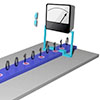| Apr 02, 2022 |
|
(Nanowerk News) According to a paper published in Nature Communications (“Electrical manipulation of skyrmions in a chiral magnet”), researchers led by Prof. DU Haifeng from the Hefei Institutes of Physical Science (HFIPS) of the Chinese Academy of Sciences, together with Prof. WANG Weiwei and Prof. SONG Dongsheng from Anhui University, and Prof. ZNAG Jiadong from the University of New Hampshire, USA, have realized integrated manipulation of magnetic skyrmions by electrical currents, including writing, erasing and addressing single skyrmions in a CoZnMn nanostripe at room temperature.
|
|
“It provides the principal foundation for constructing the skyrmion-based racetrack memories,” said DU.
|
 |
| Schematic illustration of skyrmions based racetrack memory device. (Image: WEI Wensen)
|
|
Since the prototype of skyrmion-based racetrack memory was first proposed in 2013, magnetic skyrmion has been considered as a promising data carrier for constructing the topological spintronic devices, magnetic skyrmion, a topological non-trivial vortex-like spin texture.
|
|
However, the operations of skyrmions using current-induced spin-transfer-torque in bulk chiral magnets have progressed very slowly in the past decade as the three operations of writing, erasing, and addressing skyrmions and their integration in a single micro-device remain missing.
|
|
In this research, the scientists designed and fabricated a customized chip for in-situ electrical Lorentz Transmission electron microscopy (TEM) experiments. Based on such a chip, the fabrication of the TEM microdevice was totally compatible with the conventional focus ion beam lift-out method, making the whole process efficient.
|
|
In addition, they learned from previous experience in preparing samples by ion beam focusing, and prepared CoZnMn nanostructured devices with uniform thickness and flat surface. A notch with the size of ~280 nm at the edge was designed to be comparable to the size of a single magnetic skyrmion in CoZnMn (~110 nm).
|
|
A nanosecond current pulse was introduced to manipulate the magnetic skyrmions. By controlling pulse width and current density, they achieved the gradual generation and motion of magnetic skyrmions.
|
|
Aside from that, they found that the skyrmions could be eliminated around the notch by controlling the direction of electrical current.
|
|
At last, the integrated electrical control of creating, annihilating, and displacing of magnetic skyrmions was realized in one device, demonstrating the basic functions of writing, erasing and addressing data.
|
 |
| The integrated manipulation of magnetic skyrmions by electrical currents. (Image: WEI Wensen)
|
|
The critical current density was almost one or two orders of magnitude lower than that for manipulating conventional magnetic domain walls, demonstrating the low power of skyrmion-based racetrack memories, according to Prof. DU.
|
|
These results have immediate significance towards the skyrmion-based memory or logic devices, according to the team.
|



